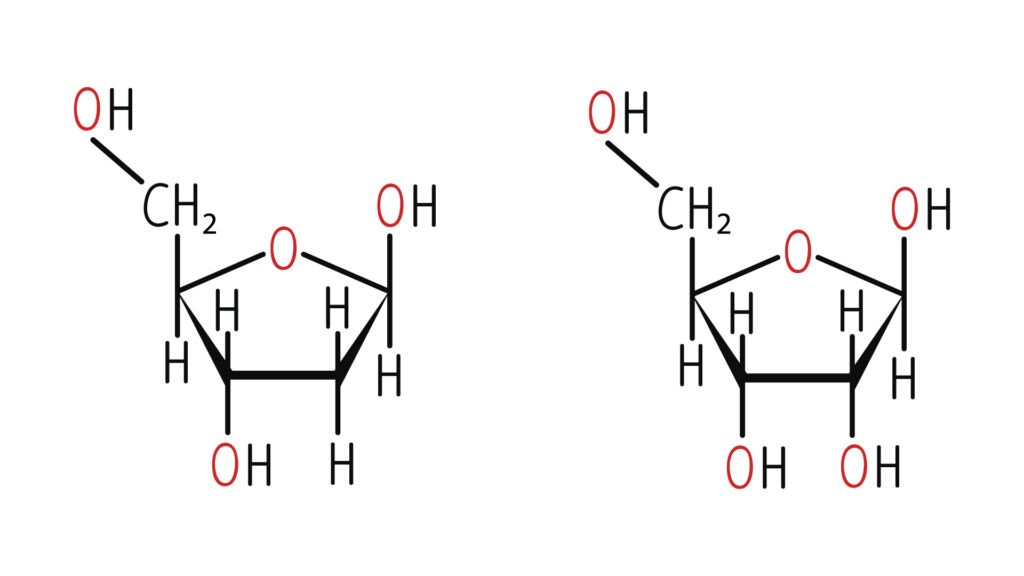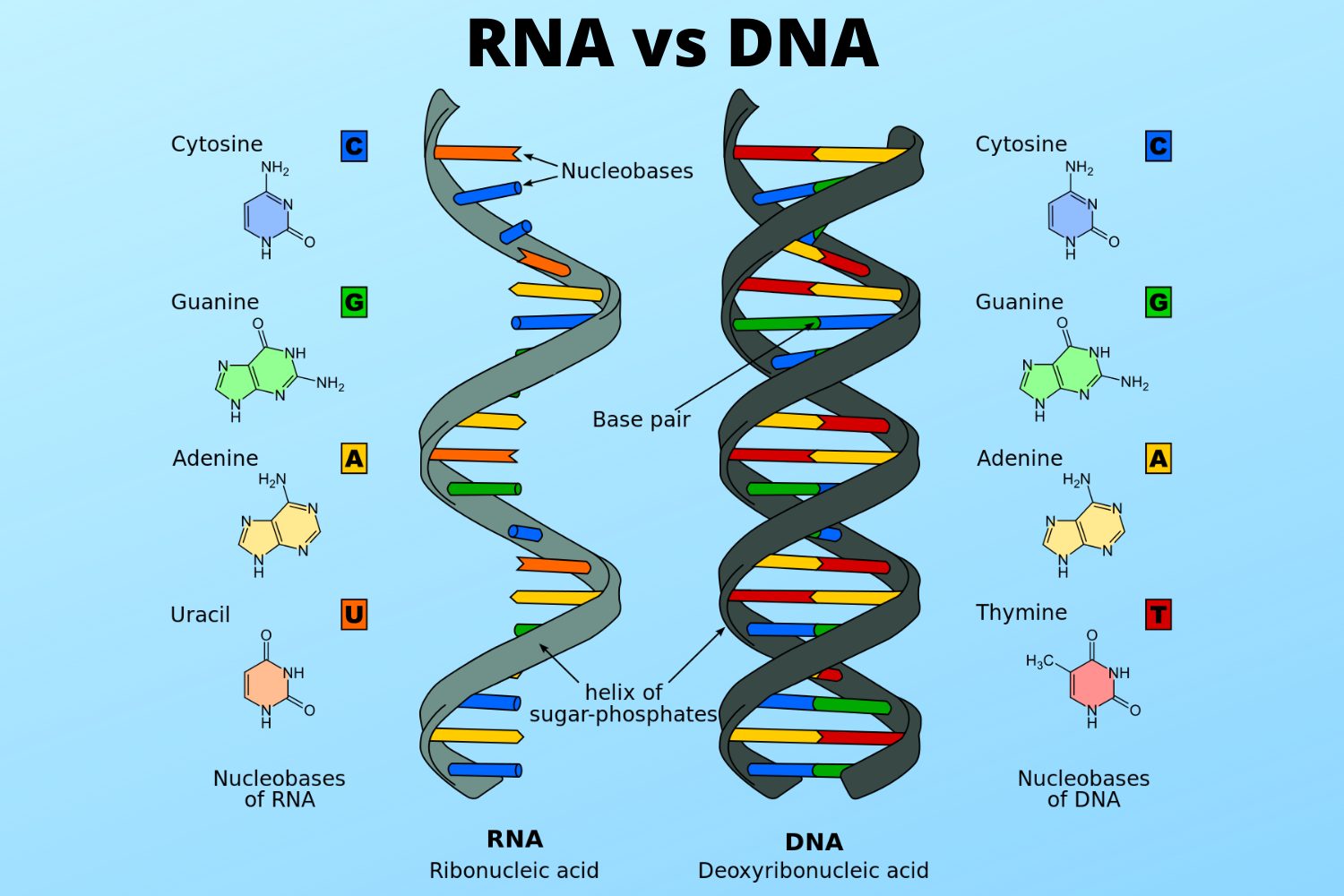In cell biology, deoxyribonucleic acid (DNA) and ribonucleic acid (RNA) are arguably the most significant molecules since they store and read the genetic information that is the basis of all life. Although they both contain bases, phosphates, and sugars and are linear polymers, there are some significant distinctions between them. The two molecules can cooperate and perform their necessary functions because to these distinctions.
Which of them Existed First?
Although there is some evidence that DNA may have initially appeared, most scientists agree that RNA evolved before DNA. According to them, RNA has a simpler structure than DNA, and DNA requires RNA in order to function. Prokaryotes, which are thought to have come before eukaryotes, are also known to have RNA. For some chemical reactions, RNA can function on its own as a catalyst.
The true question is why DNA evolved if RNA existed. The most likely explanation for this is that the presence of a double-stranded molecule aids in the protection of the genetic code against harm. The other strand might be used as a model for the restoration of the broken one. Additional defense against enzymatic attack is provided by proteins around DNA.
What are the Key Differences Between DNA and RNA?
There are five main areas where DNA and RNA differ:
- Function
- Sugar
- Bases
- Structure
- Location
Function
DNA is the blueprint from which all biological life is derived and contains all genetic information. For a long term, DNA serves as a storage mechanism, a biological flash drive that enables the transmission of the blueprint for life across generations2. RNA serves as the decoder for this flash drive. There are specific RNAs for each of the multiple phases in this reading process. The three most significant RNA types are examined in greater detail below.
Messenger RNA: In a process known as transcription, messenger RNA (mRNA) duplicates sections of the genetic code and transfers these copies to ribosomes, the cellular factories that make it possible to make proteins from this code.
Transfer RNA: In response to the encoded instructions introduced by the mRNA, transfer RNA (tRNA) transports amino acids, the fundamental protein building blocks, to these protein factories. Translation describes the process of creating proteins.
Ribosomal RNA: Protein synthesis would not be possible without ribosomal RNA (rRNA), which is a part of the ribosome factory itself.
Sugar
While the sugar used to construct both DNA and RNA is named deoxyribose (left in the image), the sugar used to construct RNA is simply referred to as ribose (right in image). The prefix “deoxy” indicates that DNA has only one hydroxyl (-OH) group connected to its carbon backbone as opposed to RNA’s two , and that it also includes a single hydrogen atom. While the deoxyribose sugar provides DNA additional stability, the extra hydroxyl group in RNA helps in the process of transcribing genetic code into mRNAs that can be translated into proteins.

Bases
Biological activity depends on the proper pairing and ordering of the nitrogen bases in DNA, which are the fundamental building blocks of genetic coding. Adenine (A), thymine (T), guanine (G), and cytosine (C) are the four bases that make up this code. In a double helix structure, bases pair off together; examples of these pairing are A and T and C and G. Thymine bases are absent from RNA, and their place is taken by uracil bases (U), which pair with adenine.
Structure
While the two-stranded format of DNA is well known due to Francis Crick and James Watson’s (or should that be Rosalind Franklin’s?). RNA’s single stranded format is not as well understood. During translation, when the molecules of mRNA and tRNA pair, RNA can form double-stranded structures. Additionally, DNA polymers are much longer than RNA polymers; the 2.3 m long human genome is made up of 46 chromosomes, each of which is a single, lengthy DNA molecule. Comparatively, RNA molecules are much smaller.
Location
The majority of the DNA in eukaryotic cells, which include all animal and plant cells, is located in the nucleus, where it is condensed into a structure called a chromosome. The DNA can be stored and transferred with ease because of this compressed format. In addition to nuclear DNA, energy-producing mitochondria, tiny organelles that are found floating freely in the cytoplasm, the region of the cell outside the nucleus, also contain some DNA.
Main places contain the three different kinds of RNA. Before leaving the nucleus and entering the cytoplasm, mRNA is created in the nucleus, with each mRNA fragment being copied from its related piece of DNA. It will then search the cytoplasm for amino acid subunits and bring them to the ribosome if it receives the proper signal from the ribosome so that they can be converted into proteins. rRNA is a component of ribosomes, as was already mentioned.
Before being exported to the cytoplasm, where some ribosomes float freely, ribosomes are first created in a region of the nucleus called the nucleolus. Other cytoplasmic ribosomes are connected to the endoplasmic reticulum, a membrane organelle that aids in the processing and exocytosis of proteins.
| Comparison | DNA | RNA |
| Name | Deoxyribonucleic Acid. | Ribonucleic Acid. |
| Structure | DNA consists of two strands, arranged in a double helix. These strands are made up of subunits called nucleotides. Each nucleotide contains a phosphate, a 5-carbon sugar molecule and a nitrogenous base. | RNA only has one strand, but like DNA, is made up of nucleotides. RNA strands are shorter than DNA strands. RNA sometimes forms a secondary double helix structure, but only intermittently. |
| Functions | Long-term storage of genetic information; transmission of genetic information to make other cells and new organisms. | Used to transfer the genetic code from the nucleus to the ribosomes to make proteins. RNA is used to transmit genetic information in some organisms and may have been the molecule used to store genetic blueprints in primitive organisms. |
| Propagation | DNA is self-replicating. | RNA is synthesized from DNA on an as-needed basis. |
| Length | DNA is a much longer polymer than RNA. A chromosome, for example, is a single, long DNA molecule, which would be several centimetres in length when unravelled. | RNA molecules are variable in length, but much shorter than long DNA polymers. A large RNA molecule might only be a few thousand base pairs long. |
| Base Pairing. | AT (adenine-thymine) GC (guanine-cytosine). | AU (adenine-uracil) GC (guanine-cytosine). |
| Ultraviolet Damage. | DNA is susceptible to UV damage. | Compared with DNA, RNA is relatively resistant to UV damage. |
| Reactivity. | The C-H bonds in DNA make it fairly stable, plus the body destroys enzymes that would attack DNA. The small grooves in the helix also serve as protection, providing minimal space for enzymes to attach. | The O-H bond in the ribose of RNA makes the molecule more reactive, compared with DNA. RNA is not stable under alkaline conditions, plus the large grooves in the molecule make it susceptible to enzyme attack. RNA is constantly produced, used, degraded, and recycled. |
